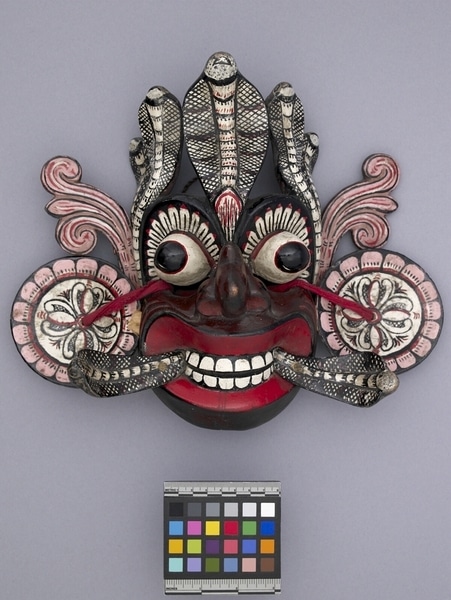Mask Item Number: Eh48 from the MOA: University of British Columbia




Description
Mask depicting the demon Gara Yaka with protruding eyes, a crooked nose with flared nostrils, wide red lips borderd in black, white teeth, curving cobras emerging from the corners of the mouth, disc-shaped concave ears, scrolling protruding elements above each ear, and a headdress formed by five cobras. The mask is painted in glossy pink, red, white and black. Strips of red fabric are threaded through the eye slits and the centre of each roundel to secure them to the mask. Twine attached at back. A label written in blue ink on the reverse reads, "Gara Yaka."
History Of Use
Worn during curing ritual of the Sanni Yakuma ceremony, part of theTovil series of dramas performed by Sinhalese ritual specialists and dancers. The Sanni Yakuma is intended to combat diseases and afflictions caused by the Sanni group of demons. These consist of 18 or more apparitions of the chief demon, Maha-Kola-Sanni. The officiating healer honours Buddha, then appeases the demons with offerings, dancing, and chanting. This Gara Yaka mask is also associated with Kolam, Devolmaduva and Gammaduva ceremonies.
Iconographic Meaning
The features of this mask class include; enormous circular ears, richly decorated with leaf, flower and petal designs, broad half-opened mouths with eyeteeth extended as great fangs, cobra kapelles (usually 3) forming a head dress, also can have big hooked noses, protruding eyes, and green painted faces. The jaw may be movable. Benevolent demons may be painted pink or yellow instead of red (or green?).
Cultural Context
exorcism
Item History
- Made in Sri Lanka before 1978
- Collected during 1978
- Owned by Jason Schoonover before February 10, 1981
- Received from Museum of Anthropology Shop Volunteers (Funding source) and Jason Schoonover (Seller) on February 10, 1981
What
- Name
- Mask
- Identification Number
- Eh48
- Type of Item
- mask
- Material
- wood, metal, plant fibre, cotton fibre ?, brass metal, paint and dye
- Manufacturing Technique
- carved, plaited, woven, nailed and painted
- Overall
- height 26.5 cm, width 31.0 cm, depth 12.3 cm
Who
- Culture
- Sinhalese
- Previous Owner
- Jason Schoonover
- Received from
- Museum of Anthropology Shop Volunteers (Funding source) and Jason Schoonover (Seller)
Where
- Holding Institution
- MOA: University of British Columbia
- Made in
- Sri Lanka
When
- Creation Date
- before 1978
- Collection Date
- during 1978
- Ownership Date
- before February 10, 1981
- Acquisition Date
- on February 10, 1981
Other
- Condition
- fair
- Accession Number
- 0704/0047